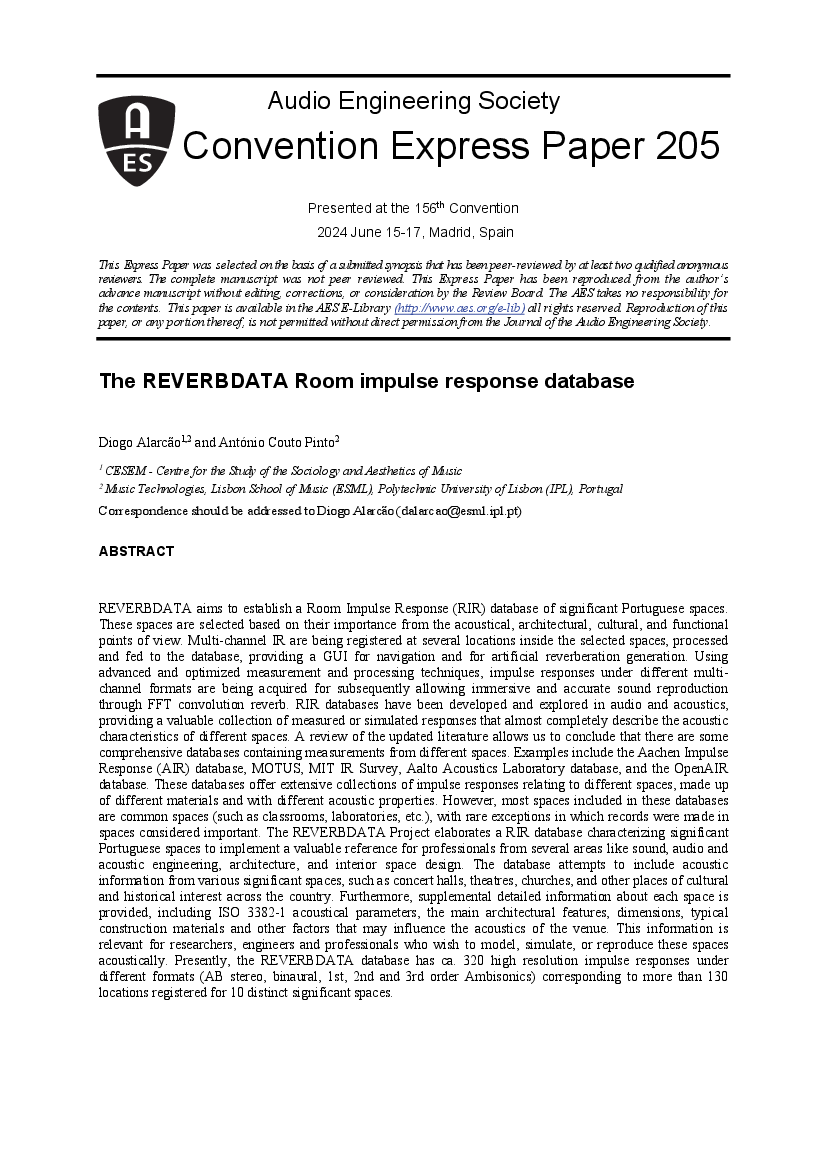Home / Publications / E-library page
You are currently logged in as an
Institutional Subscriber.
If you would like to logout,
please click on the button below.
Home / Publications / E-library page
Only AES members and Institutional Journal Subscribers can download
REVERBDATA aims to establish a Room Impulse Response (RIR) database of significant Portuguese spaces. These spaces are selected based on their importance from the acoustical, architectural, cultural, and functional points of view. Multi-channel IR are being registered at several locations inside the selected spaces, processed and fed to the database, providing a GUI for navigation and for artificial reverberation generation. Using advanced and optimized measurement and processing techniques, impulse responses under different multi-channel formats are being acquired for subsequently allowing immersive and accurate sound reproduction through FFT convolution reverb. RIR databases have been developed and explored in audio and acoustics, providing a valuable collection of measured or simulated responses that almost completely describe the acoustic characteristics of different spaces. A review of the updated literature allows us to conclude that there are some comprehensive databases containing measurements from different spaces. Examples include the Aachen Impulse Response (AIR) database, MOTUS, MIT IR Survey, Aalto Acoustics Laboratory database, and the OpenAIR database. These databases offer extensive collections of impulse responses relating to different spaces, made up of different materials and with different acoustic properties. However, most spaces included in these databases are common spaces (such as classrooms, laboratories, etc.), with rare exceptions in which records were made in spaces considered important. The REVERBDATA Project elaborates a RIR database characterizing significant Portuguese spaces to implement a valuable reference for professionals from several areas like sound, audio and acoustic engineering, architecture, and interior space design. The database attempts to include acoustic information from various significant spaces, such as concert halls, theatres, churches, and other places of cultural and historical interest across the country. Furthermore, supplemental detailed information about each space is provided, including ISO 3382-1 acoustical parameters, the main architectural features, dimensions, typical construction materials and other factors that may influence the acoustics of the venue. This information is relevant for researchers, engineers and professionals who wish to model, simulate, or reproduce these spaces acoustically. Presently, the REVERBDATA database has ca. 320 high resolution impulse responses under different formats (AB stereo, binaural, 1st, 2nd and 3rd order Ambisonics) corresponding to more than 130 locations registered for 10 distinct significant spaces.
Author (s): Alarcão, Diogo; Pinto, António Couto
Affiliation:
CESEM - Centre for the Study of the Sociology and Aesthetics of Music, and Music Technologies, Lisbon School of Music (ESML), Polytechnic University of Lisbon (IPL), Portugal; Music Technologies, Lisbon School of Music (ESML), Polytechnic University of Lisbon (IPL), Portugal
(See document for exact affiliation information.)
AES Convention: 156
Paper Number:205
Publication Date:
2024-06-06
Import into BibTeX
Permalink: https://aes2.org/publications/elibrary-page/?id=22551
(7838KB)
Click to purchase paper as a non-member or login as an AES member. If your company or school subscribes to the E-Library then switch to the institutional version. If you are not an AES member Join the AES. If you need to check your member status, login to the Member Portal.

Alarcão, Diogo; Pinto, António Couto; 2024; The REVERBDATA Room impulse response database [PDF]; CESEM - Centre for the Study of the Sociology and Aesthetics of Music, and Music Technologies, Lisbon School of Music (ESML), Polytechnic University of Lisbon (IPL), Portugal; Music Technologies, Lisbon School of Music (ESML), Polytechnic University of Lisbon (IPL), Portugal; Paper 205; Available from: https://aes2.org/publications/elibrary-page/?id=22551
Alarcão, Diogo; Pinto, António Couto; The REVERBDATA Room impulse response database [PDF]; CESEM - Centre for the Study of the Sociology and Aesthetics of Music, and Music Technologies, Lisbon School of Music (ESML), Polytechnic University of Lisbon (IPL), Portugal; Music Technologies, Lisbon School of Music (ESML), Polytechnic University of Lisbon (IPL), Portugal; Paper 205; 2024 Available: https://aes2.org/publications/elibrary-page/?id=22551